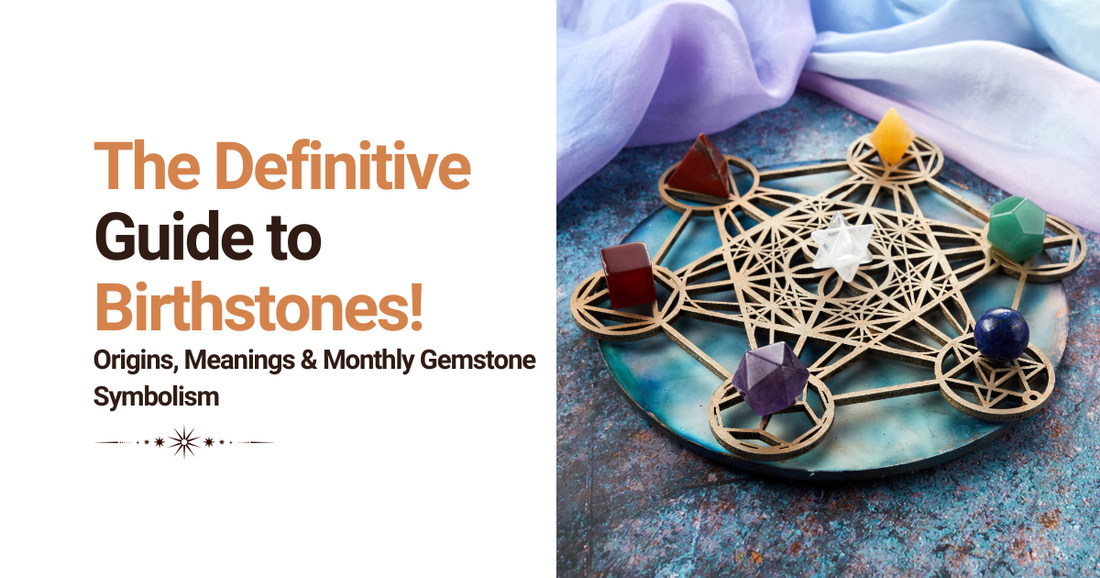
The Definitive Guide to Birthstones: Origins, Meanings & Myths
The Definitive Guide to Birthstones: Origins, Meanings & Myths
Birthstones have held a timeless allure for humankind. From ancient civilizations to modern culture, these radiant gems have been revered not just for their beauty, but also for their symbolic and healing powers.
Each month of the year is represented by one or more specific gemstones, creating a personal and spiritual connection between people and their birth month stones.
The Origins of Birthstones

The concept of birthstones is rooted in ancient religious history. The earliest known origin dates back to the Breastplate of Aaron, described in the Book of Exodus.
This ceremonial religious garment, worn by the High Priest of the Israelites, was adorned with twelve gemstones representing the twelve tribes of Israel.
The Jewish historian Josephus drew a correlation between these twelve stones, the twelve months of the year, and the twelve zodiac signs. It became common practice to own all twelve stones and wear one each month, a tradition that evolved over time into the modern idea of wearing your birth month's gemstone.
While some scholars, like George Frederick Kunz, trace the modern practice back to 18th-century Poland, others argue it began in 16th-century Germany. Over time, the specific stones have changed, influenced by cultural preferences and gem availability.
In 1912, the National Association of Jewelers in the U.S. standardized a modern birthstone list, with occasional updates such as the inclusion of Tanzanite (December) in 2002 and Spinel (August) in 2016.
Despite variations in global birthstone charts, these stones have consistently been associated with legends, therapeutic benefits, and emotional symbolism.
Monthly Birthstones: Meanings and Symbolism
January - Garnet

Derived from the Latin word "granatum" meaning "seed," Garnet resembles the pomegranate seed in color. Traditionally deep red, Garnets also come in greens (Tsavorite), purples (Rhodolite), and even color-changing varieties.
Symbolism: Passion, love, loyalty, trust. Garnets are said to promote vitality, protection, and emotional healing.
February - Amethyst

A variety of Quartz, Amethyst ranges in color from soft violet to deep purple. Ancient Greeks believed it could prevent intoxication, while Egyptians used it to guard against negative emotions.
Symbolism: Peace, inner strength, clarity of mind. Known to enhance intuition and relieve stress.
March - Aquamarine

A member of the Beryl family, Aquamarine's calming blue-green hues evoke the ocean. Historically treasured by sailors and believed to protect against sea dangers.
Symbolism: Courage, clarity, youth. Aquamarine promotes serenity and harmonious relationships.
April - Diamond

Formed under immense pressure, Diamonds are the hardest natural material on Earth. Revered across cultures, they were once thought to be divine tears or pieces of fallen stars.
Symbolism: Eternal love, strength, clarity. Diamonds are linked to courage and invincibility.
May - Emerald

Another Beryl variety, Emeralds are famous for their lush green color. Cleopatra's favorite gem, they were also sacred to Venus, the Roman goddess of love.
Symbolism: Rebirth, hope, loyalty. Emeralds are believed to bring good fortune, health, and insight.
June - Pearl

Unique among birthstones, Pearls are organic and formed within mollusks. Treasured for their elegance and purity.
Symbolism: Wisdom, purity, integrity. Pearls are thought to attract wealth and luck while calming the mind.
July – Ruby

Known as the "King of Gems," Ruby is valued for its deep red hue and association with passion and power. Ancient warriors believed Rubies granted invincibility in battle.
Symbolism: Passion, protection, prosperity. Rubies are thought to ignite confidence and attract success.
August – Peridot and Spinel

Peridot, a vibrant green stone, forms deep within the Earth's mantle. Spinel, often mistaken for Ruby, comes in a variety of colors.
Symbolism (Peridot): Strength, healing, harmony. Said to ward off nightmares and encourage growth.
Symbolism (Spinel): Renewal, energy, rejuvenation. Believed to restore vitality and bring inspiration.
September – Sapphire

Best known for its royal blue hue, Sapphire also appears in many colors except red. It has long symbolized nobility and divine favor.
Symbolism: Wisdom, loyalty, spiritual insight. Sapphires are believed to protect against negative energies and deception.
October – Opal and Tourmaline

Opal displays a play-of-color, symbolizing hope and creativity. Tourmaline comes in a rainbow of colors and is cherished for its versatile beauty.
Symbolism (Opal): Creativity, hope, emotional expression. Thought to enhance imagination and spontaneity.
Symbolism (Tourmaline): Compassion, grounding, healing. Known to balance energies and protect the wearer.
November – Topaz and Citrine

Topaz can range in color from golden to blue, while Citrine shines with warm, sunny hues.
Symbolism (Topaz): Abundance, joy, generosity. Believed to promote truth and forgiveness.
Symbolism (Citrine): Success, positivity, manifestation. Known as the "merchant's stone" for attracting wealth.
December – Turquoise, Tanzanite, and Zircon

December boasts three birthstones. Turquoise is a sky-blue gem used since ancient times. Tanzanite is a striking violet-blue stone discovered only in Tanzania. Zircon is often colorless or blue and has a brilliant sparkle.
Symbolism (Turquoise): Protection, serenity, good fortune. Worn as a talisman in many cultures.
Symbolism (Tanzanite): Transformation, intuition, higher consciousness. Encourages spiritual growth.
Symbolism (Zircon): Wisdom, honor, purity. Helps with grounding and clarity of thought.
Why Birthstones Matter Today
While skeptics may argue birthstone traditions are a marketing ploy, these gems continue to captivate hearts around the world. They serve as meaningful gifts, personal talismans, and fashion statements. Whether chosen for their symbolism or aesthetic, birthstones offer a tangible way to celebrate individuality, heritage, and emotion.
Frequently Asked Questions (FAQs)
Q1: What is the origin of birthstones?
A: Birthstones trace back to the Breastplate of Aaron in biblical times, where twelve gemstones represented the twelve tribes of Israel. The modern concept evolved in Europe and was standardized in 1912.
Q2: Are the birthstones the same worldwide?
A: Not always. Different cultures have their own versions of birthstone charts. The U.S., UK, and other countries may vary slightly in their lists.
Q3: Can I wear a birthstone not assigned to my month?
A: Absolutely. Many people choose stones based on meaning, color, or healing properties rather than their birth month.
Q4: Do birthstones really have healing powers?
A: While there is no scientific proof, many believe birthstones possess metaphysical properties that influence emotions, energy, and well-being.
Q5: What if my birth month has more than one birthstone?
A: Some months do have multiple stones, offering options based on traditional, modern, or mystical beliefs.
Explore your connection to the Earth's treasures with your birthstone and discover the magic, history, and individuality each gemstone holds. Whether for style or spirit, these timeless stones continue to enchant generations.

